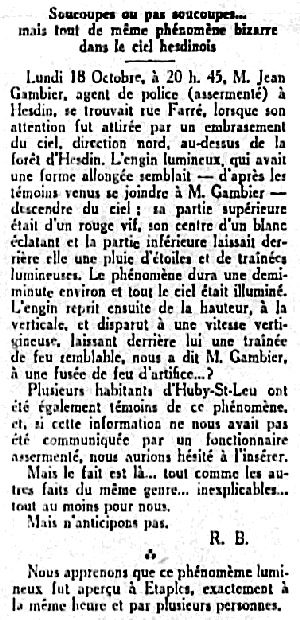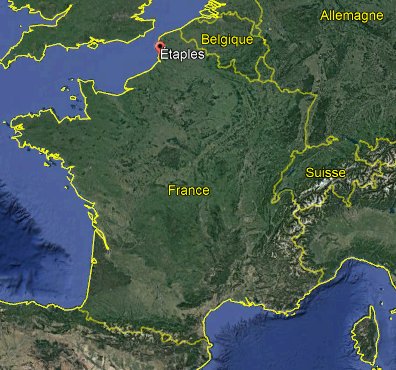
The index page for the 1954 French flap section of this website is here.
Reference for this case: 18-Oct-54-Etaples.
Please cite this reference in any correspondence with me regarding this case.
The local newspaper Le Journal de Montreuil for October 24, 1954, indicated that on october 18, 1954, at the same hour, 8:45 p.m., than the sighting in Hesdin, this luminous phenomenon was also seen in Etaples by several people.
[Ref. jdm1:] "JOURNAL DE MONTREUIL" NEWSPAPER:

|
Monday, October 18, at 8:45 p.m., Mr. Jean Gambier, police officer (sworn) in Hesdin, was on rue Farré, when his attention was drawn to a blaze of the sky, northern direction, above the Hesdin forest. The luminous craft, which had an elongated shape seemed - according to the witnesses who came to join Mr. Gambier - to descend from the sky; its upper part was bright red, its center was bright white, and the lower part left behind a shower of stars and luminous streaks. The phenomenon lasted about half a minute and the whole sky was illuminated. The craft then took height again, vertically, and disappeared at a dizzying speed, leaving behind a trail of fire, similar, Mr. Gambier told us, to a firework rocket...?
Several residents of Huby-St-Leu also witnessed this phenomenon, and, if this information had not been communicated to us by a sworn official, we would have hesitated to insert it.
But the fact is there... just like other facts of the same kind... inexplicable... at least for us.
But let's not anticipate.
R. B.
***
We learn that this luminous phenomenon was seen in Etaples, at exactly the same hour and by several people.
[Ref. abt1:] NEWSPAPER "L'ABEILLE DE LA TERNOISE":

|
In our last issue, we reported the passage of a saucer on Monday, October 18, between 8 p.m. and 9 p.m. in the evening first east of Doullens, then on Frévent and St-Pol, from where the phenomenon (or craft?) took the direction of the sea. Its route from Hem-Hardinval to Frévent is now established. It went to Montigny-les-Jongleurs, then to Beauvoir-Rivière (Somme) at the limit of the Ternoise. It seems that it took a break of half an hour to three quarters of an hour in this last town, either on the ground or at very low altitude. It allowed, in any case very instructive observations, which seem to invalidate certain hypotheses and tend to confirm others, on the nature and the means of maneuvering of these mysterious machines.
A farmer from Beauvoir-Rivière, a man already of some age, and very serious, had lingered in the fields to cover a beets silo. He suddenly saw the saucer coming towards him, at a very low altitude four or five meters and flying very slowly. "Its speed was probably not exceeding, he told us, 10 kms per hour. I had the impression that it was trying to land. It was shaped like a bell with a red light below. It seemed to me to be remarkably piloted: a small grove being in its path, it rounded it slowly, although its height would have allowed it to pass over it.
"Then an extremely curious fact happened. The saucer kept coming at me. Between it and me was a pasture closed with burl wire and iron stakes. In the falling evening this fence was practically invisible. It was necessary to know its existence. Now, on arriving there, the saucer made a right [turn] at a right angle to go alongside it, and then, arriving at the corner stake, one to the left to follow its other face, thus resuming the general north-south direction it followed before.
"Note that it could have easily flown over these fences, without risk given its height.
A curtain or crest was then to its left, it moved along it for a moment. Then pressing on this side, it took a little more height to cross it. It then flew over it, in a northwesterly direction, upward sloping fields, increasing its height accordingly, so that it continued to stay at the same distance from the ground.
"It then crossed a second ridge, similar to the first. This then hid it from my sight. I assumed it then landed in the plain above.
"This supposition seemed to me to be confirmed when, returning home three quarters of an hour later, my wife said that on returning from milking, shortly before my return, she had seen a bright red glow in the direction where the saucer was gone for me.
The cultivator only made these statements to us under the express promise not to name him. He does not want to pass for a "saucer voyeur". And that had prompted him to be silent for eight days, without telling anyone about his adventure.
We asked him the following additional questions, which we found of interest.
- Were the contours of the saucer sharp?
- No, blurry.
- Yet a metallic object standing out against the twilight sky must give sharp edges.
- It was not.
- Did the lower edge stand out more clearly on the red light?
- Neither.
- What was the appearance of this fire? That of a light? Of a lantern? Of an exhaust fire? Was it sharp? Or blurred?
- Blurred; a kind of brightness rather.
- Did you observe the appearance of the walls?
Impossible in the twilight for the whole mass, which was dark. I could only see [sic] gray canvas from the top not at all fit the silhouette of a metallic aircraft, or other material, even in the twilight. On the other hand, this blur would fit very well with a gaseous nebula formation.
We are thinking here of the theory according to which saucers "could be" vortices of grouped electrons, and taking the shape of a saucer, around a "condensing nucleus" provided either by a cosmic particle or by a radioactive particle among the millions that are thrown into the upper atmosphere by nuclear explosions.
Note that this theory would fit in with the episode of the burl wires, the vortices of electrons being known to be repelled by the metal.
As for the diffuse red light, it is accepted that such electron eddies can create phosphorescent luminosities, on contact with the neon gas floating in the lower layers of the atmosphere in the same way as the electric current, does it in a neon light tube. The experiments show that this coloring varies according to the intensity of the radio electric agent which causes them: red for the low frequencies and voltage intensities for the electric current then orange, brown, purple, even tending to green, when they increase.
Regarding this question of luminosity, let us note again that at Beauvoir-Rivière, where it was going very slowly, the saucer only showed red luminosity in its lower part, while the ten Saint-Pol residents who saw the saucer a little later (indisputably the same) noticed a dazzling tail. The light emission therefore takes on an increasing intensity with speed, the tail being explained by the very movement of the object in the air. Peremptory reversal of Lieutenant Plantier's theory, according to which the saucers would be surrounded by a belt of air moving with it: in this case there could indeed be no luminous trail, forming a tail.
Let us add that the craft was seen the same day and almost at the same time in Hesdin, Montreuil and Etaples.
The 08:45 p.m. meteor.

|
(These keywords are only to help queries and are not implying anything.)
Etaples, Etaples-sur-Mer, Pas-de-Calais, luminous, multiple, night
[----] indicates sources that are not yet available to me.
| Version: | Created/Changed by: | Date: | Change Description: |
|---|---|---|---|
| 1.0 | Patrick Gross | March 19, 2020 | First published. |
| 1.1 | Patrick Gross | October 29, 2020 | Addition [abt1]. |